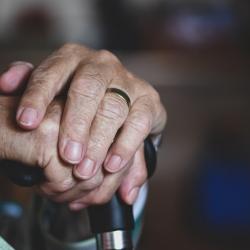What seniors and their caregivers need to know about headaches

Seniors (aged 65+) and their caregivers should be well-informed about headaches and the potential signs that may require emergency medical care. Understanding headaches, their causes, and when to seek immediate medical attention is crucial for maintaining the well-being of older individuals.
1. Headache symptoms may present differently in older individuals
It takes a different set of diagnostic criteria to determine the nature of a senior’s headache. Determining what is causing the headache or what type of headache is occurring is essential for both treatment and risk mitigation because it could be something life-threatening. Migraines, for example, often have a different set of symptoms. Whereas adults under age 65 tend to get migraines on only one side of the head, migraine in seniors is more often bilateral. Migraine in older adults can also present without sensitivity to light and sound and with less cranial autonomic symptoms (e.g. flushing, tearing, facial swelling, drooping eyelids, runny nose, pupil change, forehead sweating).[1]
2. Some headaches can indicate deeper problems, particularly in older individuals
Headaches in older adults can be caused by a variety of factors, and while most headaches are not a cause for immediate concern, there are certain situations where a headache may indicate a deeper problem requiring emergency medical care. Some of the red flags that may suggest a more serious underlying issue in an older person with a headache include:
- Sudden, severe headache: If an older person experiences a sudden and extremely severe headache, it could be a sign of a medical emergency, such as a ruptured aneurysm or a stroke.
- Diminished cognitive functioning: If the headache is accompanied by weakness, numbness, difficulty speaking, hampered vision, loss of coordination, confusion, altered consciousness, or other changes in mental status, it may be indicative of a more serious condition, such as increased intracranial pressure.
- Head injury: In older adults, head injuries are a concern because of a tendency to fall and injure oneself. A headache preceded by a fall or other head trauma may be a sign of a more serious injury, such as a subdural hematoma.
- Fever: A headache accompanied by a high fever could indicate infection or inflammation in the brain, which requires immediate medical attention.
- History of cancer or immune system disorders: Older adults with a history of cancer or immune system disorders are at a higher risk of certain complications, and new or worsening headaches in such individuals should be evaluated promptly.
- Pain with exertion or positional changes: If a headache is triggered or worsened by coughing, sneezing, bending, or other positional changes, it might be related to increased intracranial pressure and should be assessed.
- Onset after age 40: A healthcare professional should evaluate new-onset severe headaches in older adults, especially if they haven't had a history of migraines or tension headaches, to rule out more serious causes.
- Persistent and worsening headaches: If a headache is persistent, progressively worsening, or lasts for an extended period, it may indicate a more serious underlying condition.
In any of these situations, it's vital to seek emergency medical care immediately. However, even in less severe cases, if an older person experiences recurrent or bothersome headaches, it's advisable to consult with a healthcare provider for a thorough evaluation to determine the cause and identify appropriate treatment. Additionally, if the individual has a history of specific medical conditions or is taking certain medications, they should discuss their headaches with their healthcare provider to rule out any potential complications from the medications.
3. The incidence of headaches can go down with age but not always
Older people do tend to have fewer headaches on average than younger people but there’s no guarantee. Migraine, for example, can actually shift from sporadic to chronic for those in later years of life. As stated above, if you do begin to develop new headaches later in life (as opposed to recurring problems with headaches that you also dealt with when young) it’s very important to consult with your healthcare provider because it could indicate an underlying issue.
4. Headaches are often preventable and/or easily treatable
According to Arizona neurologist Dr. Andrea H. An, the “gold standard” for migraine treatment is botox injections. Botox injections target specific trigger points in the head and neck muscles to help treat migraines. Botox is a neurotoxin derived from the bacterium Clostridium botulinum. It works by blocking the release of neurotransmitters that send pain signals to the brain and by relaxing the muscle tension responsible for triggering migraines. The injections are typically administered every 12 weeks, and over time, they can reduce the frequency and severity of migraines, providing relief for those who suffer from chronic migraine headaches. Several medications are also available to treat migraines and other headaches, including many effective medications that are available without a prescription. There is no reason to live with chronic headaches (more than ten headache days per month). You can see a neurologist for Botox injections, medications, etc. A physical therapist can help you release built-up muscle tension in your head, neck, shoulders, and back, which can also help quite a lot. If you are suffering from unmanageable headaches, find a doctor who specializes in headaches.
5. There is a lack of data on headaches in older adults due to exclusion from clinical trials
Drug companies typically opt not to include older adults over age 65 in clinical trials[2] because they are more likely to have underlying conditions that make it difficult to measure the drug's effectiveness, or they may already be on many drugs that cross-react with the drug being tested. This results in a lack of data on how older adults respond to different headache interventions. This, unfortunately, means that medical providers must rely mainly on their own experience and trial and error to determine the best treatments for older patients. Hopefully, trials will include older adults in the future, but for now, the lack of empirical data is something to be aware of.
Conclusion
Headaches in older adults often manifest differently than they do in young people and can sometimes mean a dangerous health emergency is occurring or about to occur (i.e. stroke). It is very important for caregivers who work with seniors to be familiar with signs of danger and to know how to treat minor headaches effectively.
References
- Martins KM, Bordini CA, Bigal ME, Speciali JG. Migraine in the elderly: a comparison with migraine in young adults. Headache. 2006 Feb;46(2):312-6.
- Crome, Peter, Frank Lally, Antonio Cherubini, Joaquim Oristrell, Andrew D. Beswick, A. Mark Clarfield, Cees Hertogh et al. "Exclusion of older people from clinical trials: professional views from nine European countries participating in the PREDICT study." Drugs & aging 28 (2011): 667-677.
Author bio

Aaron Charlton, PhD writes about health, science, and travel topics. He did his PhD work in Consumer Behavior at the University of Oregon (’19). Aaron also writes on topics of scientific integrity and is sometimes quoted in the media on such topics.
More to Read:
Previous Posts:











